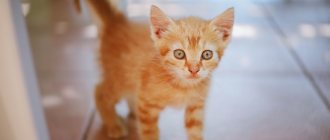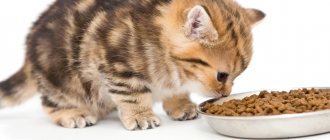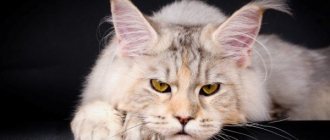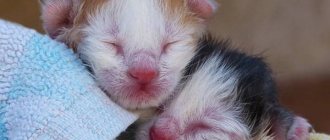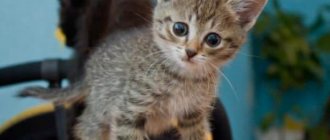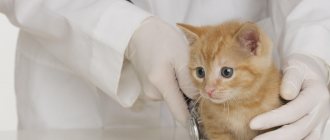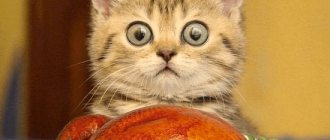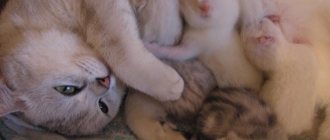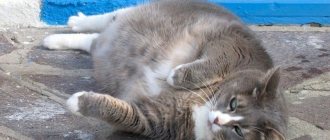Every responsible owner approaches the health of his furry pet with particular seriousness. Understanding that this factor is largely determined by several factors, the owner tries to create the most suitable conditions so that the development of kittens corresponds to all normal indicators. These include proper nutrition, the home conditions in which the animal lives, the presence of other pets in the house, and so on.
Why monitor the development of newborn kittens?
Knowing how a kitten grows and what skills it should acquire by a specific age, you can monitor your own pet. If you notice a deviation from the norm in any indicators in time, it is quite possible to eliminate it in the early stages of the problem.
The stages of growth and development of furry babies, from the moment of birth to one year, are associated with certain patterns. At the same time, each kitten is individual in its own way. Despite the fact that they go through the same stages of growing up, day by day and month by month. But they are all so different that it is impossible not to notice it even among the offspring of the same mother cat.
So, it should be noted that the first three months of a kitten’s life pass quite quickly for him. He is growing up quickly and gaining weight. This period is decisive in its further existence and development. Having overcome a kind of “critical” age threshold, most likely, everything will be fine in the future.
What should owners be wary of?
Care and attention are the most important things kittens need at this age. It is important not to miss the following points in the condition of a kitten up to 3 months:
- does not gain weight well;
- sleeps separately from the nursing cat and the rest of the litter of kittens;
- looks noticeably weaker than them;
- his mother ignores him;
- the kitten often experiences vomiting and diarrhea;
- discharge from the eyes, nose, anus.
If kittens have at least one of the above signs of pathology, they must be urgently shown to a specialist.
Milk replacers and formulas for three-week-old kittens
If a kitten is deprived of maternal care, it is fed with milk substitutes and formula. The main problem is that cat milk contains virtually no milk sugar, less fat than cow or goat milk, but contains a huge amount of proteins, beneficial bacteria and antibodies.
Important! When a kitten is fed by a cat, it develops immunity for the first three months of life. There are no artificial antibodies, so babies raised without a mother are more defenseless against viral diseases.
The daily food intake for kittens is calculated by weight:
- From birth to 7 days – 30 ml per 100 g. body weight.
- From 7 to 14 days – 35 ml per 100 g. body weight.
- From 14 to 21 days – 40 ml per 100 g. body weight.
- From 21 to 28 days – 45–48 ml per 100 g. body weight.
- From day 28 – at least 50–53 ml per 100 g. body weight.
The first days after birth
There is probably no person who does not know that newborn kittens are absolutely defenseless. They are born tiny, like little mice, blind and deaf. The only thing they need in the first weeks is their mother. She is with them almost around the clock, leaving only occasionally to eat and relieve herself. Based on the first two weeks of kitten development, it is difficult to imagine what they will look like as adult animals. Their eyes are almost completely closed, and their tiny ears seem to be neatly folded.
It is worth noting that for a kitten in the first days it is extremely important that the cat be nearby. Thermoregulation in babies is imperfect; their bodies can quickly become hypothermic or, conversely, overheat. Mom helps maintain the optimal temperature in the place where their newly-made family is located.
On the 5th-6th day, the withered umbilical cord of the furry babies falls off. Eating, sleeping and periodically defecating are all they do in their young age. The cat tries to lick each kitten: thus, she cares for the offspring, maintaining hygiene and giving them regular abdominal massages, which helps stimulate sufficient excretion of feces and urine.
First complementary foods: when to introduce and how to create a menu?
The first complementary food is introduced into the diet of artificial kittens from 4–4.5 weeks, provided that the babies are developing correctly and are interested in the smell of new food. If you fed the kitten with natural milk formula or baby food, the complementary foods should be natural:
- Whole goat or cow's milk.
- Low-fat broth (beef, rabbit, turkey).
- Boiled minced meat mixed with broth and homemade meat pate.
If you fed your baby with an industrial cat's milk substitute, you should use ready-made foods as complementary foods:
- Grind with a blender, semi-moist food, diluted with low-fat broth.
- In case of growth retardation - pate for emaciated kittens.
Introduce new foods into your kitten's diet gradually. If within 2-3 days the baby does not have digestive problems, an allergic reaction, or diarrhea, begin an active transition to adult food.
Source
Second week of life
At 10 days of age, babies' visual organs begin to open and their first hearing abilities appear. They already confidently respond to sound sources, the most significant of which for them can be called the meowing of a cat. Indeed, by 2 weeks, babies’ eyes are open, but their vision is still difficult to call clear: they see everything blurry and fuzzy.
The further development of kittens can be negatively affected by their separation from their mother at such an early age. In the first weeks after birth, for every baby, a cat is not only care, warmth and protection (including immune protection, with the help of antibodies that they receive in regular portions of colostrum and milk). Separation will also negatively affect the pet’s future relationships with people, other animals, and its learning abilities.
Rules for feeding three-week-old kittens without a mother
Three-week-old kittens are very vulnerable, although if you compare their size and potential ability to survive, you have a very good chance of being bottle-fed. It is important to understand that even if you do everything correctly, there is a risk of the kitten dying even at 3 weeks of age.
Recently, veterinarians have not recommended resorting to homemade recipes for making milk substitutes, but trying to feed kittens only with ready-made formulas. This theory may be correct, but cat milk substitutes are rarely sold in small towns and villages. Below are recommended milk substitutes and recipes for preparing the mixture at home.
The general rules for feeding three-week-old kittens without a mother are that the guardian must perform all the manipulations that are assigned to the cat:
- Heating.
- Maintaining cleanliness.
- Taking care of your health.
- Feeding.
Until the kittens’ thermoregulation stabilizes, and this will happen at the age of 1 year 1.5 months, the temperature in the nest must be maintained at 25–28 degrees. The nest should be clean, safe, and located away from drafts and heating radiators.
Be sure to massage your baby's genital area and tummy before and after feeding.
For massage, use a clean cotton sponge soaked in warm water. The general idea is that you should imitate a cat licking itself. Without these manipulations, the kitten will not be able to go to the toilet and will die within 24 hours.
Wipe the kitten's face thoroughly after feeding and make sure that its fur does not stick together. The condition of the coat is one of the main indicators of health, which you will focus on when feeding a kitten artificially.
Note! It is important to understand that even a three-week-old kitten can suffer from hereditary diseases and you may need the help of a veterinarian.
Naturally, the main aspect that ensures the survival of a three-week-old kitten that cannot eat on its own is timely, high-quality, balanced feeding. Let's take a closer look.
What you need to feed three-week-old kittens
First, let's figure out what is needed to provide the kitten with the most comfortable living and feeding conditions. Perhaps you already have something from this list; if not, you need to purchase what you need as soon as possible:
- A heating pad, preferably an electric one, with a regulator.
- Large supply of cotton and terry cuts.
- Gauze cuts and swabs.
- Cotton sponges.
- The gloves are disposable.
- Kitchen scales are the only way to track the development of a kitten, this is regular weighing.
- Moisture-wicking diapers.
Kittens at three and four weeks of age
By the beginning of the third week, small fluffy balls usually begin to emit the first purr, the picture of the visual field of any kitten becomes definite: visually they will already be able to find their mother. After a week, the development of the organs of hearing and smell ends, and the ears take shape. In addition, kittens at the age of 3-4 weeks take their first hesitant steps and pay attention to their sisters and brothers. At the same time, their baby teeth appear, the incisors emerge first, followed by the canines, premolars and molars.
At 4 weeks, you don’t have to worry about the fact that it’s too early to introduce your young pet to the toilet. It is advisable to take care of the baby and, just in case, purchase a litter tray designed for kittens. They often perceive it either as food or as a toy. Ordinary contents of the litter tray may be harmful to the animal if swallowed (for example, silica gel).
List of foods that kittens should not feed
To prevent your pet from developing health problems, the following foods should be excluded from his diet:
- Cow's milk. It causes diarrhea in kittens; cow's milk can be replaced with goat's milk.
- Fermented milk products with high fat content.
- Fish – this product can be given to adult cats, but it is not recommended for kittens.
- Salty, fried, sweet and spicy foods.
- Any sausage products.
- Potatoes in any form.
- All legume products.
- Cheese.
- Pork meat.
- Chocolate.
- Flour products.
Beginning of the second month of life
In the fifth week, the crumbs become simply unrecognizable. It seems that these “hooligans” have nothing in common with those motionless babies who were located in the nest about a month ago: they already run deftly, improve their sense of balance, can bypass obstacles, sneak up from behind and attack. By this time they are already showing concern for each other.
5 weeks is a turning point in the kitten’s nutritional system. At this age, you can try offering him complementary foods. The ideal supplementary diet (the main one is still cat milk) is canned food for kittens.
Peculiarities of behavior of kittens aged 1.5-2 months
After a couple of weeks, by the middle of the second month of life, they still bear little resemblance to adult lazy cats. Kittens constantly communicate, move actively, run, play, and sharpen their nails. A month and a half is a great time to get your first worm vaccination. If there are potentially dangerous objects in the house within easy reach of animals, it is better to remove them. This is about:
- all kinds of chemicals, detergents;
- first aid kit with medications;
- needles, pins, pushpins;
- electrical outlets;
- poisonous indoor plants, etc.
If the pet, at the request and insistence of the owner, is expected to engage in grooming in the future, then the basics of this area must be taught at 7-8 weeks. You should start with simple procedures, let the baby get used to bathing, combing fur, and cutting nails. Of course, by 2 months his claws have not yet become dangerous to others, like those of an adult animal, so there is no need to really trim them. It is important at an early age to accustom the kitten to the position in which this procedure will then take place.
At 8-9 weeks, all baby teeth are usually in place. With breastfeeding, many owners try to separate the babies and completely switch the kittens to “adult” food. Games and contact with people are especially important for small pets, so it would be better if all family members find at least 15-20 minutes every day to communicate with their pet.
First feeding
Starting from 3 weeks of age, kittens begin to be offered “adult” food. To avoid overloading the digestive tract, do this very carefully and gradually.
Unusual food is given little by little, starting with feeding once a day and increasing the number of complementary foods to 3 times a day over 7-10 days.
All food is given to babies in the form of warm puree.
Homemade food
You can start feeding small pets with natural protein products. The most suitable ones would be:
- Shaved veal. To obtain scraping, meat that has been frozen for 24-48 hours is scraped with a knife on a cutting board to form lamellar pieces. The initial size of the meat portion is comparable to the size of a pea.
- Baby meat puree in small jars.
- Liquid, well-cooked milk porridge (rice and oatmeal).
- Cream with a fat content of 9-10%.
- Fresh low-fat cottage cheese without additives.
Industrial rations
Special dry food and canned food are developed for small kittens in the 1st growth phase and ensure a safe transition from dairy food to adult food. They contain proteins, fats, vitamins and minerals that ensure the proper development of the kitten, but do not create a burden on the immature digestive system.
According to breeders, the leader in this area is Royal Canin Babycat 34.
Its small pieces have a delicate texture, quickly swell in water and turn into a nutritious paste.
Also watch the video on how to feed a newborn kitten without a cat:
Development in kittens after three months of life
After three months of age, it is difficult to notice radically noticeable changes in the development of furry babies. True, they grow intensively for up to six months. From 12 weeks to 6 months, they undergo natural preparation for independent living, acquiring fundamental skills and abilities through constant play.
During this period, a feature of the psychological development of almost sexually mature adult cats is the building of a hierarchy. The determination of the leader and subordinate members of their society, which includes people, is an essential component of the relationship between animals of a given species and other inhabitants of the house. It is not surprising that upon reaching 6 months of age, having grown stronger and gaining sufficient confidence in their own abilities, they test the limits of what is permitted, often challenging the owner.
What to feed a kitten?
It is very important to remember that all food intended for your pet should be at room temperature.
The main products that should be included in the animal’s diet:
- Meat – it should be lean. It is best if it is chicken, veal, beef or turkey. Meat can be given scalded, frozen or boiled.
- Liver – can be given 1 or 2 times a week.
- Porridge – this product must be included in your pet’s diet. If the kitten does not want to eat the porridge in its pure form, it can be mixed with meat.
- Fresh or boiled vegetables.
- Egg yolk.
- Fermented milk products with low fat content.
- A small amount of Vaseline oil.

